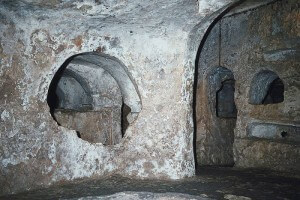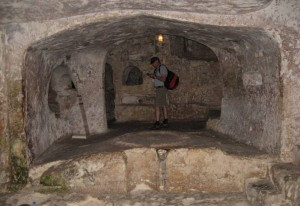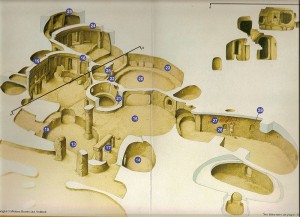 7
7




 7
7

 1
1

 09. 05. 2024
09. 05. 2024

 08. 05. 2024
08. 05. 2024

 07. 05. 2024
07. 05. 2024
 18. 12. 2023
18. 12. 2023

Many mysteries and secrets are kept by the hypogeum (underground temple) Ħal Saflieni, which is located in the town of Paola in Malta. According to scientists, the temple was carved into the limestone about six to seven thousand years ago. This means that Safal Saflieni is thousands of years older than the Egyptian pyramids at Giza, which are considered to be the oldest architectural monuments in the world.
But what civilization has built a multilevel branched labyrinth? What functions did the underground structure actually perform? And finally, where do these wonderful builders, whose traces are lost in time, share? Current science cannot give exact answers.
The discovery of world significance
Safal Saflieni was discovered completely by accident. In 1902, intensive housing construction took place in the suburb of Paola. The builders began construction of another house and drilled a well into the rock, where there was to be a reservoir for collecting water. At the same time, however, it turned out that there was a kind of cavity in the rock layers.
And, although it was clear that the cave was of artificial origin, the builders, who did not want to lose their profits, ordered the workers to continue working, and began to pour construction debris into the cave.
But once a Jesuit, Father Emanuel, visited the building. He realized the significance of this discovery and obtained permission from the city council to start excavations. Inside the underground cavities, with a number of conical and ovoid spaces, the Jesuit discovered the human skeleton, and therefore, initially, leaned towards the idea that it was the burial ground of an underground temple from the early Christian period.
However, the fact that no Christian symbolism was found inside the caves contradicted this assumption. The walls were covered with geometric patterns, mostly spirals. In addition to humans, the remains of sacrificed animals were discovered, which also contradicted the original hypothesis.
 After the death of Father Emanuel, in 1907, excavations by the Maltese archaeologist Temi Zammit continued. His most significant discovery was the Hall of Prophets with remarkable acoustic properties, which we will mention below. Zammit assumed that in ancient times there was a pilgrimage oracle in the temple, to which the inhabitants of all the countries around the Mediterranean went.
After the death of Father Emanuel, in 1907, excavations by the Maltese archaeologist Temi Zammit continued. His most significant discovery was the Hall of Prophets with remarkable acoustic properties, which we will mention below. Zammit assumed that in ancient times there was a pilgrimage oracle in the temple, to which the inhabitants of all the countries around the Mediterranean went.
Maria Gimbutas, an American archaeologist and culturologist of Lithuanian descent, believed that Safal Saflieni was a shrine to the goddess of fertility, Mother Earth. It came to this conclusion on the basis of the fact that some areas of the hypogea have the shape of the womb.
In addition, during excavations, a small clay figurine of an obese woman lying on her side, in the position of an embryo, was discovered (this is the position of most of the XNUMX human skeletons found in Safal Saflieni's burial chambers). This statuette was named "Sleeping Great-grandmother".
Most contemporary scholars consider Ħal Saflieni to be an underground temple dedicated to the cult of birth and death. It has 34 rooms on three levels with a total area of about 500 square meters. They are interconnected by transition tunnels and stairs. It's quite a tangled labyrinth, in which you get easily lost.
In 1980, the hypogeum was added to the list of the most important UNESCO cultural monuments.
This is probably the most interesting object. It is located on the second level of hypogea. In this room, at the height of a person's face of average height, there is a small oval niche. If someone speaks in a deep voice, the sound, amplified many times, will be heard throughout all the underground rooms. But if anyone speaks in a loud voice, even those standing nearby will not hear him.
The acoustic exploration conducted by a group of Italian scientists by Maltese composer Ruben Zahra showed that the sound in the Hall of Wisdom resonates at the frequency of the 110 hertz, which corresponds to the resonance frequencies of many other ancient buildings, specifically Irish New Grange.
Similar acoustic effects have a huge impact on the human psyche. According to scientists, the sound of a similar frequency seems to turn on the area of the brain that is in charge of a person's emotional state, compassion and social behavior. In addition, one who is in hypogene feels this sound vibration through all the tissues and bones of his body.
This leads to some change in consciousness and, probably, intensifies mystical perception during the ritual. This would be assumed that Safal Saflieni was really built as an underground temple. But there is another hypothesis about the purpose of the "Hall of Prophecies", to which we will return later.
Chamber that does not return
At the third level of hypogea are niches, called burial chambers, because human remains have been found in some of them. They are so low that it is possible to look into them only in kneeling, and get inside - by crawling. These chambers lead nowhere, except for one, which has an opening on the opposite wall, opening into a dark tunnel.
In 1940, a well-known researcher, Louisa Jessup, who then worked at the English Embassy in Malta, visited the hypogeum. During the excursion, she managed to persuade the guide to allow her to get into this mysterious niche.
The guide did not agree first, but was eventually forced to retreat under the pressure of an eccentric stranger. He only warned her that it was very dangerous and that she was not responsible for the consequences.
 Louisa Jessup took a candle and ordered her friends to secure it with her long scarf. When she managed to push through the hole, the brave researcher found herself standing on a small rock ledge at the edge of a narrow but apparently very deep abyss, beyond which she could make out the outlines of a huge hall.
Louisa Jessup took a candle and ordered her friends to secure it with her long scarf. When she managed to push through the hole, the brave researcher found herself standing on a small rock ledge at the edge of a narrow but apparently very deep abyss, beyond which she could make out the outlines of a huge hall.
On the other side of the abyss, a little closer, was the same ledge, and behind it immediately began a tunnel that led to the depths of the rock. Next to him, Jessup saw some hairy, human-like creatures. One of the creatures threw a stone at her. Scared to death, she threw herself back. The guide in her fright was not surprised in the slightest, he seemed to know very well what she might see there.
One week later, a group of 30 students with their teacher were in hypogee. It turned out that they had gone to the very place where Miss Jessup had escaped. Whether it was a coincidence or not, there was a collapse in that passage at that time.
The search squad instead explored, but they found only the rupture of the protective rope that the pupils used to pull from the funeral chambers. The rope was cut with something sharp. No traces of children or their teachers have been found.
After this event, the Maltese heard a child's cry and screams coming from underground in different parts of the island. But they couldn't figure out exactly where the sounds came from. It is said that a network of catacombs runs under the whole island, even beyond its borders, perhaps as far as Italy. And that it is not wise to get lost in this labyrinth, the beginning of the underground is in hypogee.
But who built such an underground miracle? And where did the ancient civilization disappear?
Astrophysicist Anatoly Grigoryevich Ivanov believes that more than XNUMX years ago, newcomers from the star systems Nemesis and Syria lived in Shal Saflien.
The hypothesis looks very attractive. But for some reason, our esteemed scientist believes that in those days, Earthlings simply could not have the technology to cut rocks as easily as they would drive a butter knife. And it follows that only aliens could do it.
But what if there really existed a long-developed, highly developed civilization, and the myth about Atlantis is true? And why can not we assume that Ħal Saflieni was a huge refuge where the people hid in the threat of nuclear war or other dangers?
 Then we could easily explain the presence of seven thousand human skeletons, people, dead, presumably, at the same time as the victims of a terrible war that also destroyed this civilization. And it is possible that the niche in the Hall of Wisdom was a means of informing the involuntary inhabitants of this oldest protective bunker.
Then we could easily explain the presence of seven thousand human skeletons, people, dead, presumably, at the same time as the victims of a terrible war that also destroyed this civilization. And it is possible that the niche in the Hall of Wisdom was a means of informing the involuntary inhabitants of this oldest protective bunker.
Based on this hypothesis, we could explain the mystery of the lowest chamber of the hypogea. The steps that lead to it end a few meters above floor level. Why? Probably because there was a well with water, which was taken for cooking and other uses.
I believe that the hypothesis of an ancient refuge has the same right to exist as everyone else. And the underground shrine became seal Saflieni only later, in ancient times.
The people who gradually settled in Malta used the fruits of labor of much older and unknown civilizations. Whatever it is, the mysteries of Ħal Saflieni, as well as before, still disturb the scientists and the flow of tourists who wish to visit the Hypogeum, immaculate.